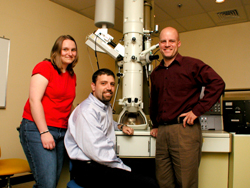|
May 24, 2002--Scientists from the University of Delaware and the University of California-Santa Barbara are working together to produce new biomaterials that could lead to important advances in plastics and human health.
In fact, it is possible that the research could someday result in the development of much-needed replacement organs to save the lives of individuals in failing health.
 |
| Biomaterials researchers Lisa Pakstis, Bulent Ozbas and Darrin Pochan. |
The research, which involves self-assembling synthetic polypeptides inspired by natural proteins, is reported in the May 23 issue of Nature magazine.
“The paper describes our collaborative, interdisciplinary efforts to produce new, advanced biomaterials,” Darrin J. Pochan, assistant professor in the University of Delaware’s Department of Materials Science and Engineering, said.
Pochan said many scientists worldwide are focusing on the production of new biomaterials but noted “what makes this research unique is the way we are doing it, through designed molecular self-assembly.”
“We can design into a molecule all the information it needs so that when it is thrown into an aqueous solution, it will self-assemble into a material with a desired structure and function,” Pochan said.
At the foundation of the new biomaterials are polypeptides, molecular chains of amino acids and “the same chemistry as found in our bodies,” he said. “We are using molecular tools inherent in natural biomolecules to design our synthetic polypeptides and the ultimate properties of the assembled material.”
Several inherent properties are unique to this new class of self-assembled, peptide-based hydrogels, Pochan said.
As described in the Nature article, the underlying self-assembled polypeptide scaffold has a porous microstructure, a structure not observed in, and difficult to process into, traditional hydrogel materials, Pochan said.
The gel scaffold is also porous on the nanoscale, he said, which allows the gel to easily and quickly reassemble after flow or processing.
Furthermore, Pochan said, the gels are stable up to the boiling point of water and, being peptide based, should be “enzymatically degradable and easily made useful for further biofunctionality.”
A technology that can take advantage of these unique hydrogel properties is the engineering of human body tissue and Pochan said that, looking far to the future, it is conceivable that this work could lead to the generation of transplantable organs and tissues that would not be rejected because they would be created using cells from a patient's own body and thus have the same genetic material.
The microscale porosity and peptidic nature of the gel network are both desired ingredients for interaction with living human cells.
“When a person is young, we could potentially take tissue samples and grow copies of their organs for when they are needed,” Pochan said. “That’s a Holy Grail kind of thing, but it is what motivates further development of our work.”
The work also could have applications in other biomedical fields, such as drug delivery and biomineralization, and even have potential applications in more traditional plastics technology, Pochan said.
“One could potentially produce tough plastics with inherent biofunctionality (e.g., antimicrobial properties) with block copolypeptides simply by choosing the correct amino acids in your polymer,” he said.
Working in Pochan’s research group at UD, and coauthors of the paper, are graduate students Lisa Pakstis and Bulent Ozbas.
UC-Santa Barbara researchers who coauthored the paper are Andrew P. Nowak, Victor Breedveld, David J. Pine and Timothy J. Deming.
The National Science Foundation funds the Pochan group’s research.
|

